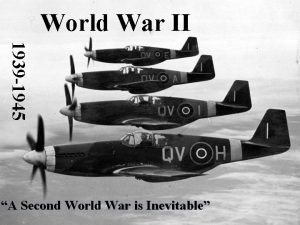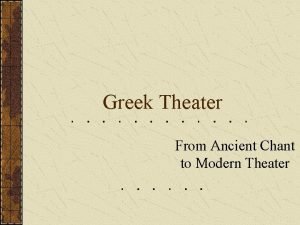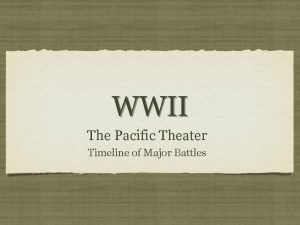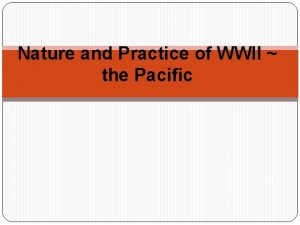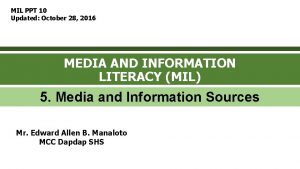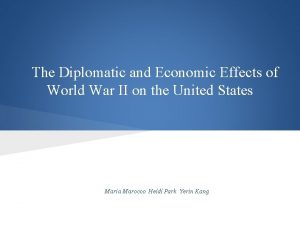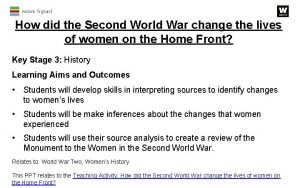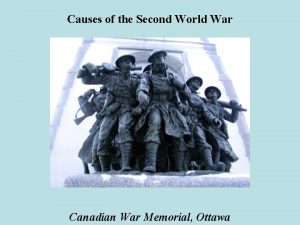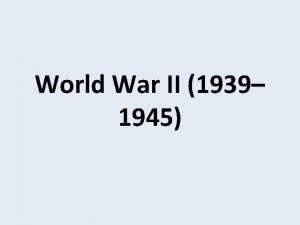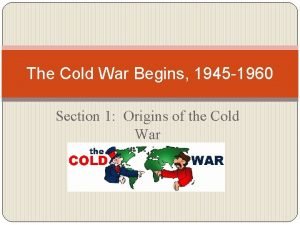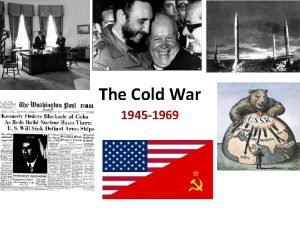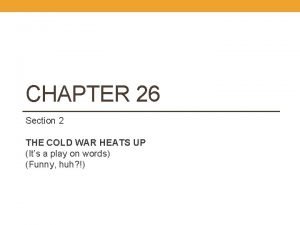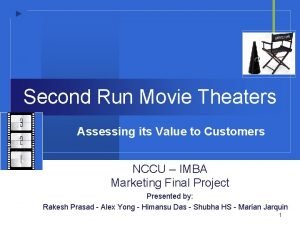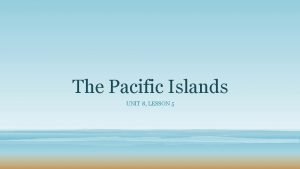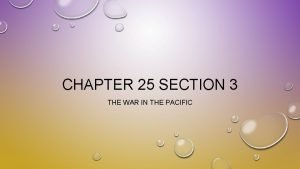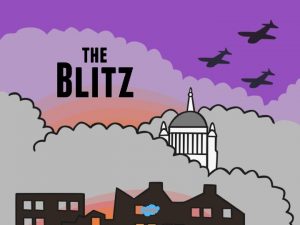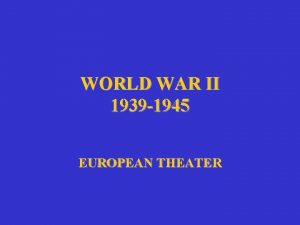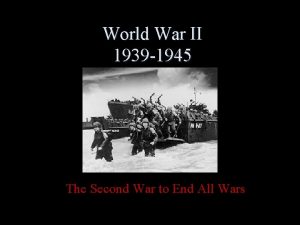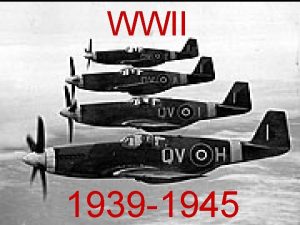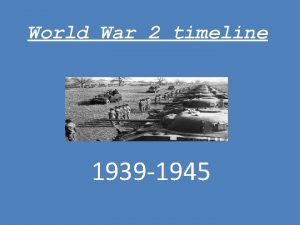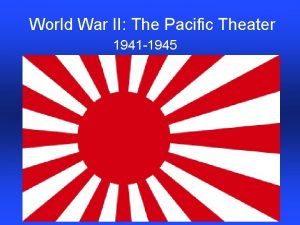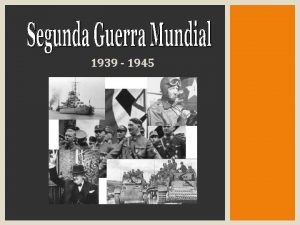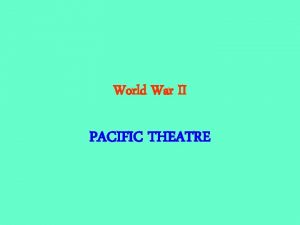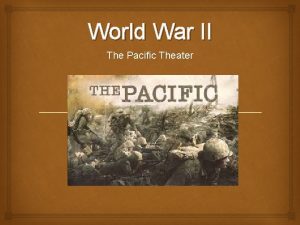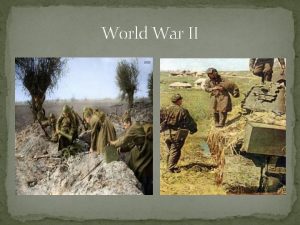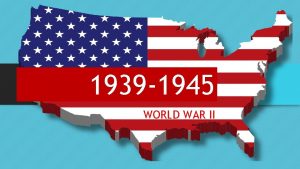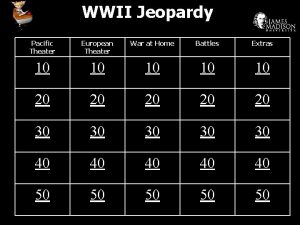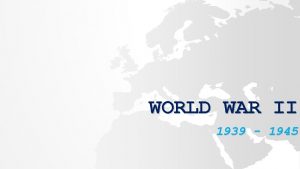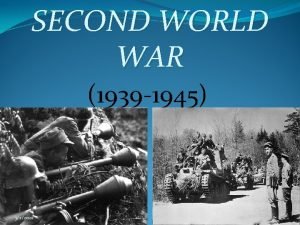The Second World War Pacific Theater 1939 1945


















- Slides: 18

The Second World War Pacific Theater (1939 -1945)

“Pearl Harbor: A Day That Will Live in Infamy. ” I. Pearl Harbor (Hawaii) A. December 7, 1941. B. Japanese carrier planes attacked U. S. military installations at Pearl Harbor. 1. U. S. Pacific fleet severely damaged. a. Eight U. S. battleships sunk or severely damaged. 2. U. S. aircraft at Wheeler and Hickam airfields blown up on runways. 3. Over 2, 000 U. S. sailors, soldiers, and airmen killed or wounded. C. Attack was a tactical victory… but several targets missed. 1. Oil refineries, dry docks (ship repair centers), and carriers. 2. Aircraft carriers were not at Pearl Harbor (main target)

“Pearl Harbor: A Day That Will Live in Infamy. ” Eight U. S. battleships sunk or severely damaged The attack on Pearl Harbor was a tactical victory, but the Japanese failed to strike several targets including the oil refineries, dry docks (ship repair centers), and aircraft carriers.

“Pearl Harbor: A Day That Will Live in Infamy. ” II. The United States declared war on Japan, (Dec. 8, 1941) President Roosevelt: An angry U. S. nation declared war on Japan, Dec. 8, 1941, the day after the Japanese attack at Pearl Harbor. Japanese Admiral Yamamoto: Planned the attack on Pearl Harbor. Before the war, he attended school at Harvard. He died in a 1943 plane crash. After the attack he commented, “I’m afraid we have only awakened a sleeping giant. ”

1941 -1942: Japanese Victories in the Pacific I. With the destruction of the United States fleet at Pearl Harbor, the Japanese steamrolled throughout the western Pacific and Southeast Asia. A. Guam and Wake fell in December 1941. B. Hong Kong was taken by Christmas. C. Burma and the Netherlands East Indies fell in March 1942. Banzai!!! After Pearl Harbor, the Japanese occupied much of the Pacific unopposed.

The Japanese Conquer the Philippines II. The Japanese attacked the Philippines. A. U. S. troops on Bataan held out until April 1942. 1. In the Bataan “Death March, " 75, 000 troops from the U. S. garrison were marched 55 miles to a railhead. More than 7, 000 died along the way. B. U. S. troops on Corregidor surrendered on May 5, 1942. 1. “I shall return, " General Douglas Mac. Arthur. C. By the spring of 1942, Japan was dominant throughout Southeast Asia and the Western Pacific. Douglas Mac. Arthur: The Bataan Death March: In the Bataan "death march, " 75, 000 troops from the U. S. garrison were marched 55 miles to a railhead. More than 7, 000 died along the way. President Roosevelt ordered Mac. Arthur to flee the Philippines. Mac. Arthur pledged upon his arrival to Australia, “I Shall Return. ”

Map of Japanese Conquest, 19411942

Battle of Midway: The Turning Point II. Battle of Midway (June 4 -6, 1942) A. Japanese Admiral Yamamoto wanted to lure the weakened American fleet out of Hawaii and destroy it with an overwhelming Japanese naval fleet. 1. Planned to follow up with an invasion of Midway and the Hawaiian Islands. B. Due to an intelligence break the U. S. carriers knew of the Japanese plans and set a trap for the Japanese fleet. 1. The U. S. navy sank four Japanese carriers and forced Japanese navy to retreat. C. Called the turning point of the Pacific War.

Guadalcanal: Pushing the Japanese Back Begins I. Guadalcanal (August 1942 -February 1943) A. Small island located near the Solomon Islands. 1. The U. S. attack was intended to capture the Japanese airfield and secure a foothold for the long and bloody path to push the Japanese back. a. The brutal and vicious fighting at Guadalcanal shaped the nature of combat between Japanese and Americans in the Pacific. B. Guadalcanal represented the first defeat for Japan on land marked a shift in momentum and initiative to the United States.

U. S. vs. Japanese Strategies for Victory (1943 -1945) I. U. S. Strategy: “Island Hopping” A. Strategy called for by-passing many Japanese held islands and cutting off Japanese supply routes. II. Japanese Strategy: “Bushido” A. Japanese code of honor (fight unto death. ) 1. Suicide for the Japanese is more acceptable in their culture. 2. Disgraced Japanese officers and soldiers were expected to kill themselves rather than surrender. 3. Viewed Americans as cowards for surrendering.

Island Hopping Map (1943 -1945)

The United States Recapture the Philippines I. The recapture of the Philippines (December 1944 to March 1945. ) A. General Mac. Arthur returned in 1944 by landing at Leyte Gulf. 1. Brutal fighting for Manila (Philippine capital). B. The Bataan Peninsula and Corregidor fell in late February 1945. C. "I have returned. ” 1. Mac. Arthur sent troops to each of the surrounding Philippine islands, ignoring the high command's decision to bypass them. 1. Mac. Arthur was determined to keep his promise to the U. S. soldiers he left there and who suffered greatly under Japanese captivity in early 1942. D. The battle for the Philippines was Japan's most costly defeat in the entire war.

Manhattan Project I. The Manhattan Project A. A joint United States and British development of an atomic bomb. 1. The United States hoped to shock the Japanese into an unconditional surrender. B. Successful testing of the bomb on July 15, 1945 at Alamogordo, New Mexico. 1. Japanese were threatened with "complete and utter destruction" if they failed to accept. a. The Navy argued that a blockade and air raids were sufficient to secure the Japanese surrender, while the Army advocated the use of the atomic bomb. 1 a. Neither an effective blockade nor terror bombing had succeeded in ending the war. 2 a. The Japanese military showed no sign of surrendering. 2. The United States considered demonstrating the bomb before using it on a Japanese target. a. Availability of only two bombs discouraged the use of one for demonstration purposes.

Atomic Bombs- Hiroshima I. Hiroshima (Aug. 6, 1945) A. The first atomic bomb was on the Japanese city of Hiroshima. B. Enola Gay (Plane that dropped the first atomic bomb on Hiroshima) 1. Bomb’s nickname “Little Boy” C. Destroyed 60 percent of the city and killed between 80, 000 to 100, 000 Japanese. 1. Some people were burnt to ashes and only their shadows burnt onto walls remained. D. The Soviet Union declared war on Japan on August 8, 1945, shortly after the Hiroshima bombing. Little Boy: The bomb dropped on Hiroshima Aug. 6, 1945. A Pocket watch found at Hiroshima after the explosion. *Note the time the watch stopped.

Atomic Bombs- Nagasaki II. Nagasaki (Aug. 9, 1945) A. The second atomic bomb was on the Japanese city of Nagasaki. B. Bockscar (Plane that dropped the atomic bomb on Nagasaki) 1. Bomb’s nickname “Fat man” C. Killed approximately 35, 000 people. 1. By December 1945, an additional 40, 000 died from radiation. D. Japanese military continued to reject surrender even after Nagasaki after the atomic bomb. Survivors of the Nagasaki bombing.

The Atomic Bombs III. Reasons for the bombings. A. Alternative to an invasion of Japan. B. To scare the Russians. 1. Truman wanted to have an upper hand in post-war politics. IV. Effects of the atomic bombs: A. Radiation, heat, explosion, and radioactive fallout. B. For several weeks after the Hiroshima attack, people died of radiation sickness. More deaths occurred as a result of firebombing Tokyo It was estimated that one million U. S. soldiers would have died had we needed to invade mainland Japan. Clothing was burned onto the victims skin.

Japan Surrenders I. The Unconditional Surrender of Japan. A. The Japanese government agreed to surrender if the Japanese emperor would not be imprisoned. B. On August 14, 1944 Hirohito addressed the Japanese nation that the war was over. 1. August 14, 1944 was designated as V-J Day (Victory Over Japan). C. September 2, 1945. (The war is officially over. ) The official unconditional surrender of Japan took place aboard the U. S. S. Missouri in Tokyo Bay on Sept, 2, 1945.

The U. S. Occupation of Japan and the Tokyo War Crime Trials II. Tokyo War Crime Trials. A. Tojo and the Japanese warlords were sentenced to death. 1. Emperor Hirohito allowed was to continue his reign. III. General Mac. Arthur was selected as military governor of Japan. A. Began restructuring Japanese society, including women’s right to vote. B. Refused to allow the Soviet Union to occupy Japan like Germany. Tojo, the Japanese Prime Minister attempted suicide, but U. S. forces rushed him to the hospital, saved his life, then put him on trial for war crimes. He was found guilty and executed. General Mac. Arthur was selected as military governor of Japan
 1945 world war ii
1945 world war ii 1945 world war
1945 world war Greek theater vs modern theater
Greek theater vs modern theater Pacific theater timeline
Pacific theater timeline Fdrs quarantine speech
Fdrs quarantine speech School uniform of sshs prior to the second world war
School uniform of sshs prior to the second world war Effects of ww2
Effects of ww2 Second world war
Second world war Second world war
Second world war Pemenang perang dunia 2
Pemenang perang dunia 2 The cold war begins 1945-1960
The cold war begins 1945-1960 The cold war heats up: 1945 - 1969
The cold war heats up: 1945 - 1969 The cold war heats up chapter 26 section 2
The cold war heats up chapter 26 section 2 Second run theater
Second run theater Civil war readers theater
Civil war readers theater Unit 8 lesson 5
Unit 8 lesson 5 Chapter 25 section 3 the war in the pacific
Chapter 25 section 3 the war in the pacific 186 282 miles per second into meters per second
186 282 miles per second into meters per second Dubai population pyramid
Dubai population pyramid
